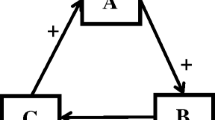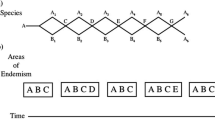Abstract
The ‘species problem’ in the philosophy of biology concerns the nature of species. Various solutions have been proposed, including arguments that species are sets, classes, natural kinds, individuals, and homeostatic property clusters. These proposals parallel debates in ecology as to the ontology and metaphysics of populations, communities and ecosystems. A new solution—that species are processes—is proposed and defended, based on Robert Ulanowicz’s metaphysics of process ecology. As with ecological systems, species can be understood as emergent, autocatalytic systems with propensities for centripetality and mutuality in the course of dynamically balancing ascendency (order and persistence) and overhead (randomness and change). The species-as-processes perspective accords with the Ulanowicz’s postulates of process ecology and it can be accommodated by existing theories of species—particularly in a reframing of Richard Boyd’s metaphysics such that species are homeostatic process clusters. Rather than contending that process-based metaphysics is the only, best or true account of species, a pluralist-realist approach is advocated based on the pragmatic principles that are reflected in modern view of species and ecology. If species are understood to be comprised of processes and to be emergent processes themselves, there are important implications for the life sciences, including: animal models in medical and environmental studies, conservation biology, extinction, biodiversity, restoration ecology, and evolutionary biology.


Similar content being viewed by others
References
Ayala FJ, Arp R (2009) Contemporary debates in philosophy of biology. Wiley-Blackwell, New York
Bateson G (1972) Steps to an ecology of mind. Ballantine Books, New York
Bickhardt MH, Campbell DT (1999) Emergence. In: Anderson PB, Emmeche C, Finnemann NO, Christensen PV (eds) Downward causation. Aarhus University Press, Aarhus
Boyd R (1999) Homeostasis, species, and higher taxa. In: Wilson RA (ed) Species: new interdisciplinary essays. MIT Press, Cambridge
Bradshaw AD (2000) What do we mean by restoration? In: Urbanska KM, Webb NR, Edwards PJ (eds) Restoration ecology and sustainable development. Cambridge University Press, Cambridge
Brown B, de Laplante K, Peacock K (2011) Philosophy of ecology. Elsevier (North Holland), New York
Buck RC, Hull DL (1966) The logical structure of the Linnaean hierarchy. Syst Zool 15:97–111
Cairns J (1988) Increasing diversity by restoring damaged ecosystems. In: Wilson EO (ed) Biodiversity. National Academy Press, Washington, DC
Caro TM, O’Doherty G (1999) On the use of surrogate species in conservation biology. Conserv Biol 13:805–814
Clements FE (1936) Nature and the structure of climax. J Ecol 24:252–284
Dodds W (2009) Laws, theories and patterns in ecology. University of California Press, Berkeley
Donlan CJ, Berger J, Bock CE, Bock JH, Burney DA, Estes JA, Foreman D, Martin PS, Roemer GW, Smith FA, Soule ME, Greene HW (2006) Pleistocene rewilding: an optimistic agenda for twenty-first century conservation. Am Nat 168:660–681
Elsasser WM (1969) A causal phenomena in physics and biology: a case for reconstruction. Am Sci 57:465–523
Elsasser WM (1981) A form of logic suited for biology? In: Rosen R (ed) Progress in theoretical biology, vol 6. Academic Press, New York
Ereshefsky M (1992) The units of evolution: essays on the nature of species. MIT Press, Cambridge
Ereshefsky M (1999) Species and the Linnaean hierarchy. In: Wilson RA (ed) Species: new interdisciplinary essays. MIT Press, Cambridge
Ghiselin MT (1966) On psychologism in the logic of taxonomic controversies. Syst Zool 15:207–215
Ghiselin MT (1969) The triumph of the Darwinian method. University of California Press, Berkeley
Ghiselin MT (1974) A radical solution to the species problem. Syst Zool 23:536–544
Glass B (1960) Eighteenth-century concepts of the origin of species. Proc Am Philos Soc 104:227–234
Grant V (1981) Plant speciation. Columbia University Press, New York
Gregg JR (1950) Taxonomy, language and reality. Am Nat 84:419–435
Griffiths GCD (1974) On the foundations of biological systematics. Acta Biotheor 23:85–131
Hull DL (1976a) Are species really individuals? Syst Zool 25:174–191
Hull DL (1976b) The ontological status of biological species. In: Butts R, Hintikka J (eds) Boston studies in the philosophy of science, vol 32. D. Reidel, Dordrecht
Hull DL (1978) A matter of individuality. Philos Sci 45:335–360
Hull DL, Ruse M (1998) The philosophy of biology. Oxford University Press, New York
Johns Hopkins Center for Alternatives to Animal Testing (2011) http://caat.jhsph.edu/. Accessed 27 April 2011
Keller DR, Golley FB (2000) The philosophy of ecology: from science to synthesis. University of Georgia Press, Athens
Kitcher P (1984) Species. Philos Sci 51:308–333
Kitts DB, Kitts DJ (1979) Biological species as natural kinds. Philos Sci 46:613–622
Kolasa J, Pickett STA (1991) Ecological heterogeneity. Springer, New York
Korey K (1984) The essential Darwin. Little, Brown & Company, Boston
Lehman H (1967) Are biological species real? Philos Sci 34:157–167
Lockwood JA (2004a) Locust: the devastating rise and mysterious disappearance of the insect that shaped the American frontier. Basic Books, New York
Lockwood JA (2004b) Tales from a species’ crypt. Conserv Pract 5:20–27
Lockwood JA (2010) The fate of the Rocky Mountain locust, Melanoplus spretus Walsh: implications for conservation biology. Terr Arthropod Rev 3:129–160
Lockwood DR, Lockwood JA (1997) Evidence of self-organized criticality in insect populations. Complexity 2:49–58
Lovelock J (2000) Gaia: a new look at life on earth. Oxford University Press, New York
Maclaurin J, Sterelny K (2008) What is biodiversity?. University of Chicago Press, Chicago
Matthews RW, Matthews JR (2009) Insect behavior. Springer, New York
Mayr E (1976) Is the species a class or an individual? Syst Zool 25:192
McCann KS (2000) The diversity-stability debate. Nature 405:228–233
Mishler B, Donoghue M (1982) Species concepts: a case for pluralism. Syst Zool 31:491–503
Parker KA, Seabrook-Davison M, Ewen JG (2010) Opportunities for nonnative ecological replacements in ecosystem restoration. Restor Ecol 18:269–273
Pimm SL (1991) The balance of nature? Ecological issues in the conservation of species and communities. University of Chicago Press, Chicago
Popper KR (1990) A world of propensities. Thoemmes, Bristol
Quine WVO (1969) Natural kinds. In: Quine WVO (ed) Ontological relativity and other essays. Columbia University Press, New York
Reiners WA, Lockwood JA (2010) Philosophical foundations for the practices of ecology. Oxford University Press, New York
Rescher N (2008) Process philosophy. Stanford encyclopedia of philosophy. http://plato.stanford.edu/entries/process-philosophy/. Accessed 26 April 2011
Rheinberger H-J, Müller-Wille S (2009) Genes. Stanford encyclopedia of philosophy. http://plato.stanford.edu/entries/gene/. Accessed 26 April 2011
Rosenberg A, McShea DW (2007) Philosophy of biology: a contemporary introduction. Routledge, New York
Roughgarden J (2004) Evolution’s rainbow: diversity, gender, and sexuality in nature and people. University of California Press, Berkeley
Ruse M (1969) Definitions of species in biology. Brit J Philos Sci 20:97–119
Ruse M (1971) The species problem: a reply to Hull. Brit J Philos Sci 22:369–371
Ruse M (1998) Philosophy of biology. Prometheus, New York
Serafini A (2001) The epic history of biology. Basic Books, New York
Shapiro G (1973) Habit and meaning in Peirce’s pragmatism. Trans Charles S Peirce Soc 9:24–40
Shayne CG (2006) Animal models in toxicology. Informa Healthcare, London
Sober E (1993) Philosophy of biology. Westview, Boulder
Sterelny K (1999) Species as ecological mosaics. In: Wilson RA (ed) Species: new interdisciplinary essays. MIT Press, Cambridge
Townsend CR, Begon M, Harper JL (2003) Essentials of ecology. Blackwell, Malden
Ulanowicz RE (1995) Ecosystem trophic foundations. In: Patterson BC, Jorgensen SE (eds) Complex ecology: the part-whole relation in ecosystems. Prentice-Hall, Englewood Cliffs, NJ
Ulanowicz RE (1997) Ecology, the ascendent perspective. Columbia University Press, New York
Ulanowicz RE (2001) The organic in ecology. Ludus Vitales 9:183–204
Ulanowicz RE (2005) Fluctuations and order in ecosystem dynamics. Emerg Complex Organ 7:14–20
Ulanowicz RE (2009) A third window: natural life beyond Newton and Darwin. Templeton Foundation Press, West Conshohocken
Vrba ES (1995) Species as habitat-specific complex systems. In: Lambert DM, Spencer HG (eds) Speciation and the recognition concept: theory and applications. Johns Hopkins University Press, Baltimore
Wiens JA, Hayward GD, Holthausen RS, Wisdom MJ (2008) Using surrogate species and groups for conservation planning and management. BioScience 58:241–252
Wilmers CC (2004) The role of wolves as a keystone species: Examining the ecological effects and conservation implications of a reintroduced top predator on the scavenger guild, Yellowstone National Park. US Environmental Protection Agency website http://cfpub.epa.gov/ncer_abstracts/index.cfm/fuseaction/display.abstractDetail/abstract/6782/report/0. Accessed 27 April 2011
Wilson EO (1980) Sociobiology. Harvard University Press, Cambridge
Wilson EO (1988) Biodiversity. National Academy Press, Washington, DC
Wimsatt WC (2000) Emergence as non-aggregativity and the biases of reductionism(s). Found Sci 5:269–297
Zagzebski LT (2008) On epistemology. Wadsworth, Florence
Zorach AC, Ulanowicz RE (2003) Quantifying the complexity of flow networks: how many roles are there? Complexity 8:68–76
Author information
Authors and Affiliations
Corresponding author
Rights and permissions
About this article
Cite this article
Lockwood, J.A. Species are Processes: A Solution to the ‘Species Problem’ via an Extension of Ulanowicz’s Ecological Metaphysics. Axiomathes 22, 231–260 (2012). https://doi.org/10.1007/s10516-011-9169-5
Received:
Accepted:
Published:
Issue Date:
DOI: https://doi.org/10.1007/s10516-011-9169-5




